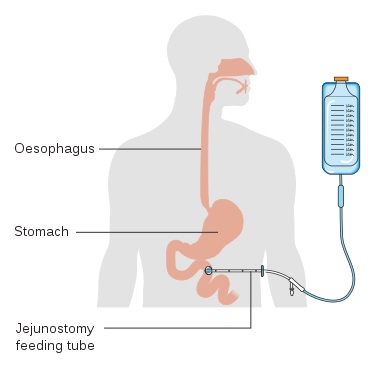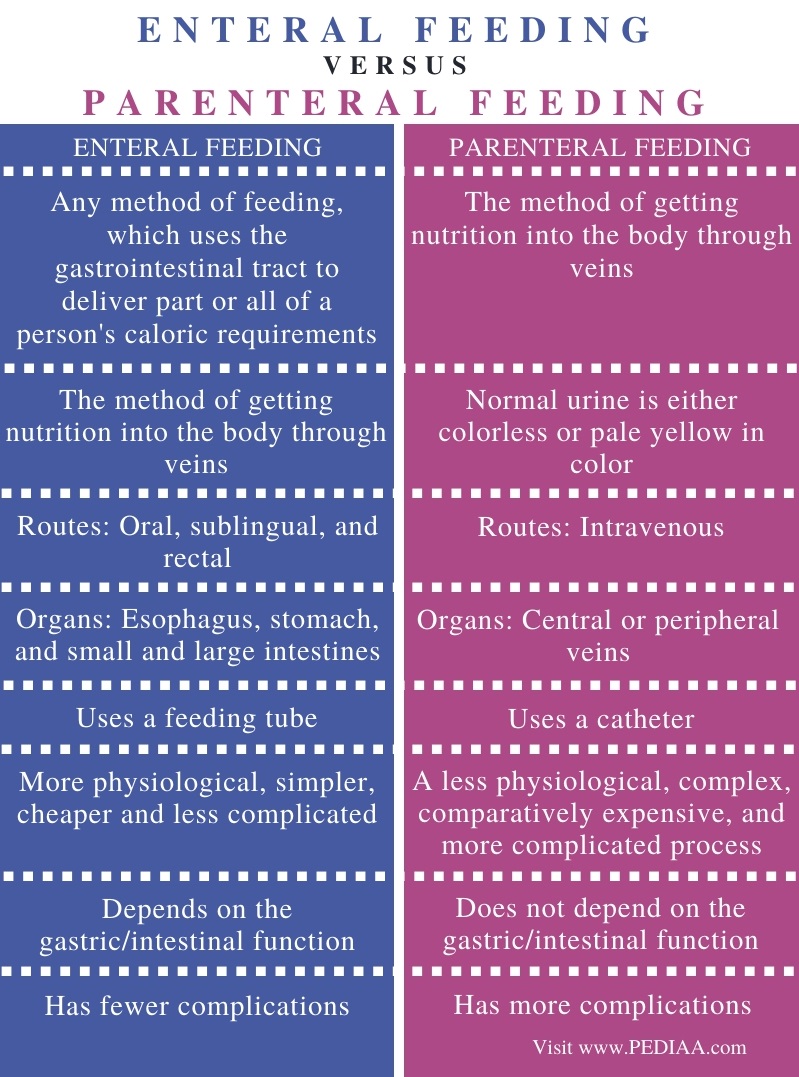enteral vs parenteral nutrition
However the role that enteral nutrition plays in preventing. In general enteral nutrition is preferred over parenteral nutrition when both options are on the table.

Gi Enteral And Parenteral Nutrition Flashcards Quizlet
Enteral nutrition is the process of nourishing a patient with a liquid diet of defined composition usually given through a na-sogastric nasointestinal gastrostomy or jejunostomy tube.

. The main difference between enteral and parenteral feeding is that enteral feeding is the delivery of food via the human gastrointestinal tract. The rationale for prescribing enteral nutrition rather than parenteral nutrition PN is based on the superior maintenance of intestinal structure and function 2 reduced infection rates 3 and reduced cost of enteral alimentation. Up to 10 cash back The median of duration of parenteral and enteral nutrition before surgery was 147 months among patients who received parenteral and enteral nutrition before surgery n 92 and it was shorter in age 30 years group than in age 30 years group median.
The aim of this study was to compare enteral nutrition EN and parenteral nutrition TPN in terms of adequacy of nutritional intake septic and nonseptic morbidity and mortality. The enteral feeding involves the esophagus stomach and small and large intestines but the parenteral feeding involves the. No delay in caloric intake.
However even nasogastric feeding needs care and the more complex types of enteral nutrition such as gastrostomy and jejunostomy need significant interventions. Among them five were EEIN vs. Enteral nutrition is administered through a feeding tube placed into the stomach or intestines.
12 Moreover it has been recently shown that patients fed via EN after abdominal surgery for trauma developed. It was reported in animals that enteral nutrition more so than does parenteral nutrition lowers the risk of infection by preserving the gastrointestinal tracts integrity and enhancing its ability to provide an immunocompetent barrier to endogenous gut bacteria which prevents the occurrence of bacterial translocation 37 39. Parenteral nutrition is the administration of nutrients directly into the bloodstream through a central venous catheter or by peripheral infusion.
All trials were performed to compare enteral ecoimmunonutrition with enteral nutrition or parenteral nutrition ENPN. Less need for interruptions. Safe and less need for mechanical ventilation and better muscle mass if used early when relative CI to enteral nutrition Doig et al 2013 ANZICS trial Disadvantages.
The choice between enteral and parenteral nutrition In general enteral nutrition is preferred to parenteral nutrition as it is more physiological simpler cheaper and less complicated. For patients with physical disabilities or movement disorders enteral nutrition might be used in the long. We provide a narrative review of more recent studies and technical reviews comparing enteral nutrition with parenteral nutrition.
Enteral feeding involves delivering liquid foods through a catheter inserted directly into the gastrointestinal tract whereas parenteral feeding involves providing nutrients directly into the blood stream. Enteral nutrition EN is recommended as the preferred route for early nutrition therapy in critically ill adults over parenteral nutrition PN. Via nasojejunal tube feeding total parenteral nutrition or early enteral nutrition.
If the GI tract remains functional enteral nutrition is preferred over parenteral nutrition because it is associated with fewer infectious complications and is significantly less expensive. Can be started early. Many Upper GI surgeons traditionally use TPN as opposed to early enteral nutrition citing the need to protect the newly formed anastomosis post total-gastrectomy.
In contrast parenteral feeding is the delivery of food into the bloodstream bypassing the gut. Controversy persists as to the optimal means of providing adjuvant nutritional support. EN 20 22 23 24 28 and four were.
Multiple techniques are used to give post-operative nutritional support ie. Guidelines Medicare Coverage of nutritional therapy is provided under the prosthetic device benefit provision which requires that the patient must have a permanently inoperative internal body organ or function thereof. Figure 15-1 Selecting a Feeding Route.
Supplemental parenteral nutrition combined with enteral nutrition can be considered to cover the energy and. Enteral nutrition is chosen over parental for the following reasons. Enteral feeding delivers liquid nutrition through a catheter inserted directly into the gastrointestinal GI tract.
Contrary to former beliefs recent meta-analyses of ICU studies showed that parenteral nutrition is not related to a surplus mortality and may even be associated with improved survival. Early enteral nutrition is recommended for critically ill patients. IQR 61436 months p.
It is a strong and commonly held belief among nutrition clinicians that enteral nutrition is preferable to parenteral nutrition. With enteral nutrition1516 Finally enteral nutrition even that in volving invasive placement of gastric or jejunal tubes is approximatelly 4 to 10- fold less expensive than parenteral nutri tion. Enteral versus parenteral nutrition.
ENTERAL NUTRITION EN is considered to be better than total parenteral nutrition TPN for providing feeding in various clinical settings because it is less expensive safer and maintains the nutritional metabolic immunological and barrier function of the intestines. Enteral vs Parenteral. IQR 61142 months vs median.
What is the difference between enteral and parenteral routes of administration. A recent large randomized controlled trial RCT showed no outcome differences between the two routes. On either enteral or parenteral nutritional therapy depending upon the particular nature of their medical condition.
In most cases the foodstuffs are liquid and they usually come through a series of tubes and catheters. The site of entry of the tube and tube types will be discussed under enteral access Parenteral nutrition refers to the delivery of calories and nutrients into a vein. In the low risk situations enteral feeding is more preferred than parenteral feeding.
It can include a normal oral diet the use of liquid supplements or delivery by use of a tube tube feeding. Does not rely of gastricintestinal function. Parenteral nutrition by contrast provides nutrition intravenously which means it goes directly into the bloodstream.
Parenteral nutrition is administered through a traditional intravenous IV line or via a central IV surgically placed during an outpatient procedure. The average daily cost of total parenteral nutrition TPN hereafter referred to as central parenteral nutrition. To date specialized enteral nutri tional products have been developed for use in prematurity enriched with essen.
For patients without a functional GI tract parenteral nutrition would be recommended for them as enteral nutrition would not work. Enteral nutrition is typically used as a short-term solution while the patient is recovering from surgery illness or an injury.

What Is The Difference Between Enteral And Parenteral Feeding Pediaa Com

Enteral And Parenteral Nutrition American College Of Gastroenterology

Feeding Methods Healthcare Nutrition Council

What Is The Difference Between Enteral And Parenteral Feeding Pediaa Com

Enteral And Parenteral Nutrition American College Of Gastroenterology

Comparison Of Enteral And Parenteral Feeding Download Table

Enteral Feeding Brain Visceral Interactions In The Processing Of Nutrients Intechopen
0 Response to "enteral vs parenteral nutrition"
Post a Comment